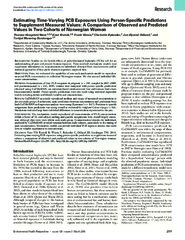| dc.contributor.author | Nøst, Therese Haugdahl | |
| dc.contributor.author | Breivik, Knut | |
| dc.contributor.author | Wania, Frank | |
| dc.contributor.author | Rylander, Charlotta | |
| dc.contributor.author | Odland, Jon Øyvind | |
| dc.contributor.author | Sandanger, Torkjel M | |
| dc.date.accessioned | 2016-03-16T07:22:48Z | |
| dc.date.available | 2016-03-16T07:22:48Z | |
| dc.date.issued | 2015 | |
| dc.description.abstract | Background: Studies on the health effects of polychlorinated biphenyls (PCBs) call for an
understanding of past and present human exposure. Time-resolved mechanistic models may
supplement information on concentrations in individuals obtained from measurements and/or
statistical approaches if they can be shown to reproduce empirical data.
<p>Objectives: Here, we evaluated the capability of one such mechanistic model to reproduce
measured PCB concentrations in individual Norwegian women. We also assessed individual lifecourse
concentrations.
<p>Methods: Concentrations of four PCB congeners in pregnant (n = 310, sampled in 2007–2009)
and postmenopausal (n = 244, 2005) women were compared with person-specific predictions
obtained using CoZMoMAN, an emission-based environmental fate and human food-chain
bioaccumulation
model. Person-specific predictions were also made using statistical regression
models including dietary and lifestyle variables and concentrations.
<p>Results: CoZMoMAN accurately reproduced medians and ranges of measured concentrations in
the two study groups. Furthermore, rank correlations between measurements and predictions from
both CoZMoMAN and regression analyses were strong (Spearman’s r > 0.67). Precision in quartile
assignments from predictions was strong overall as evaluated by weighted Cohen’s kappa (> 0.6).
Simulations indicated large inter-individual differences in concentrations experienced in the past.
<p>Conclusions: The mechanistic model reproduced all measurements of PCB concentrations
within a factor of 10, and subject ranking and quartile assignments were overall largely consistent,
although they were weak within each study group. Contamination histories for individuals
predicted by CoZMoMAN revealed variation between study subjects, particularly in the timing of
peak concentrations. Mechanistic models can provide individual PCB exposure metrics that could
serve as valuable supplements to measurements.
<p>Citation: Nøst TH, Breivik K, Wania F, Rylander C, Odland JØ, Sandanger TM. 2016.
Estimating time-varying PCB exposures using person-specific predictions to supplement measured
values: a comparison of observed and predicted values in two cohorts of Norwegian women.
Environ Health Perspect 124:299–305; http://dx.doi.org/10.1289/ehp.1409191 | en_US |
| dc.description | Published version, also available at <a href=http://dx.doi.org/10.1289/ehp.1409191>http://dx.doi.org/10.1289/ehp.1409191</a> | en_US |
| dc.identifier.citation | Environmental Health Perspectives 2015, 124(3) | en_US |
| dc.identifier.cristinID | FRIDAID 1257447 | |
| dc.identifier.doi | 10.1289/ehp.1409191 | |
| dc.identifier.issn | 0091-6765 | |
| dc.identifier.uri | https://hdl.handle.net/10037/8972 | |
| dc.identifier.urn | URN:NBN:no-uit_munin_8558 | |
| dc.language.iso | eng | en_US |
| dc.publisher | National Institute of Environmental Health Sciences (NIEHS) | en_US |
| dc.relation.projectID | Norges forskningsråd: AMOM-SIS | |
| dc.relation.projectID | Helse Nord RHF: Not specified | |
| dc.rights.accessRights | openAccess | |
| dc.subject | VDP::Medisinske Fag: 700::Basale medisinske, odontologiske og veterinærmedisinske fag: 710::Toksikologi: 730 | en_US |
| dc.subject | VDP::Medical disciplines: 700::Basic medical, dental and veterinary science disciplines: 710::Toxicology: 730 | en_US |
| dc.title | Estimating Time-Varying PCB Exposures Using Person-Specific
Predictions to Supplement Measured Values: A Comparison of
Observed and Predicted Values in Two Cohorts of Norwegian
Women | en_US |
| dc.type | Journal article | en_US |
| dc.type | Tidsskriftartikkel | en_US |
| dc.type | Peer reviewed | en_US |


 English
English norsk
norsk